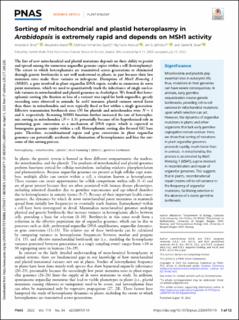Sorting of mitochondrial and plastid heteroplasmy in Arabidopsis is extremely rapid and depends on MSH1 activity
Broz, Amanda K.; Keene, Alexandra; Gyorfy, Matheus Fernandes; Hodous, Mychaela; Johnston, Iain; Sloan, Daniel B.
Journal article, Peer reviewed
Published version

Åpne
Permanent lenke
https://hdl.handle.net/11250/3061925Utgivelsesdato
2022Metadata
Vis full innførselSamlinger
- Department of Mathematics [939]
- Registrations from Cristin [9791]
Originalversjon
Proceedings of the National Academy of Sciences of the United States of America. 2022, 119 (34), e2206973119. 10.1073/pnas.2206973119Sammendrag
The fate of new mitochondrial and plastid mutations depends on their ability to persist and spread among the numerous organellar genome copies within a cell (heteroplasmy). The extent to which heteroplasmies are transmitted across generations or eliminated through genetic bottlenecks is not well understood in plants, in part because their low mutation rates make these variants so infrequent. Disruption of MutS Homolog 1 (MSH1), a gene involved in plant organellar DNA repair, results in numerous de novo point mutations, which we used to quantitatively track the inheritance of single nucleotide variants in mitochondrial and plastid genomes in Arabidopsis. We found that heteroplasmic sorting (the fixation or loss of a variant) was rapid for both organelles, greatly exceeding rates observed in animals. In msh1 mutants, plastid variants sorted faster than those in mitochondria and were typically fixed or lost within a single generation. Effective transmission bottleneck sizes (N) for plastids and mitochondria were N ∼ 1 and 4, respectively. Restoring MSH1 function further increased the rate of heteroplasmic sorting in mitochondria (N ∼ 1.3), potentially because of its hypothesized role in promoting gene conversion as a mechanism of DNA repair, which is expected to homogenize genome copies within a cell. Heteroplasmic sorting also favored GC base pairs. Therefore, recombinational repair and gene conversion in plant organellar genomes can potentially accelerate the elimination of heteroplasmies and bias the outcome of this sorting process.
